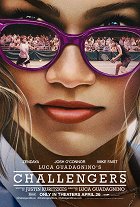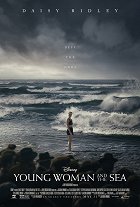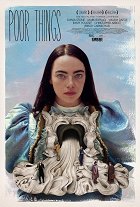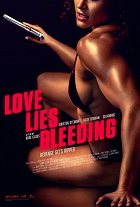Romance - Genres
Hottest on Streaming Today
Basic characteristics of the romantic film
Romantic films represent a genre that emphasizes a love motive of (usually two) protagonists. This also defines their main plot, which can revolve around all possible forms of partner love: passionate, platonic, tragic, forbidden, destructive, fickle, reciprocated and unrequited, fleeting and long-lasting, and also love at first sight. Typically, the protagonists are a man and a woman who fall in love, woo each other, then are forced to overcome a series of obstacles or relationship complications, and finally end up embracing, confessing their mutual love, confirming it with a kiss, implying the fairy-tale ending "and they lived happily ever after". Many romantic films may also culminate in a marriage proposal or a wedding, but some end sadly, either with the death of one or both protagonists or their break-up.
Other common themes are, for example, overcoming age, ethnic or social differences between the protagonists, overcoming prejudice, quarrels with disapproving parents, partner disagreements and communication problems, dating and getting to know each other, intimacy and sex, unexpected separations and long-distance relationships, fidelity and infidelity, love triangles, and sometimes also financial difficulties or a struggle with a serious illness. Some romantic films are narratively, thematically and psychologically very complex and contain fundamental ideas and messages, while others are simpler and serve purely for recreational entertainment and escapism. In both cases, however, they have an emotional impact on the audience through strongly expressed feelings and in a certain way reflect on partner and love relationships. The work with clichés plays a key role, together with a somewhat predictable and schematic narrative structure, unfolding from the story of two characters looking for ways of mutual recognition and possible merging of life paths.
Sub-types of romantic films
The most common sub-genre is the romantic comedy, which combines a romantic plot and humour, in which the main characters are two attractive and usually well-to-do people who are fated for each other, and their happy endings can serve to encourage viewers in their pursuit of partner life and to strengthen their confidence in the institution of marriage. Their plot is usually quite banal, but beneath the trivial surface there can be a complex web of meanings and references to the social context of their time. Romantic dramas, in contrast, approach the story with all seriousness and throw their heroes into major complications, which then become an ordeal that tests the strength of their love. It is usually not clear in advance whether they will be able to overcome everything, or whether for some reason they will be prevented from continuing the relationship (for example, due to the death of one of them). The category of romantic dramas usually includes historical romances, in which the loving and often epic plot is set in a specific period of history, often intertwined with military conflicts.
A special category is the fantasy romance, in which the central romantic line is enhanced by fairytale and fantasy elements. A subset of this is the paranormal romance, in which at least one of the lovers is a supernatural being, such as an angel, vampire, ghost, werewolf, wizard, or other unreal entity. In addition, the romantic genre can be intertwined with other genres, so that we can talk about romantic musicals, thrillers, sci-fi, crime, horror, westerns and many other combinations. Ultimately, then, a film of any other genre whose plot is based, among other things, on a strong romantic line with the protagonists as its focus can be described as romantic.
A Jitney Elopement (1915)
Photo © The Essanay Film Manufacturing Company
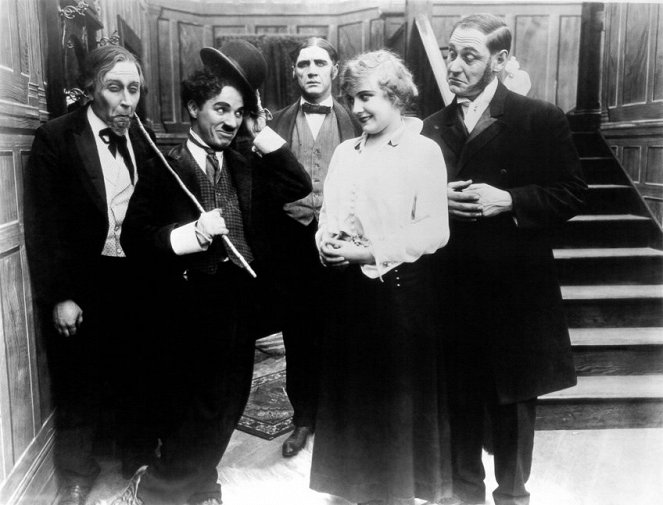
Romantic films of the silent era and romantic grotesques
Romantic elements have been present in cinema since its early beginnings. For example, the capture of a kiss (a rather controversial act at the time) was the subject of the shorts The Kiss (1896) and The Kiss in the Tunnel (1899). Later on, romantic themes found their way into the plots of the shorts The Pasha's Daughter (1911), All for a Girl (1912) and The Sea Urchin (1913), among others, as well as into a number of films directed by D.W. Griffith such as Broken Blossoms (1919), True Heart Susie (1919), A Romance of Happy Valley (1919), Way Down East (1920), Dream Street (1921) and Drums of Love (1928). The 1920s also saw a naive silent romance between a British woman and an Arab sheik called The Sheik (1921), a drama about a courtesan in love, Camille (1921), and a drama about a former prostitute and lover of a married man, Zaza (1923). Other romantic films include Flesh and the Devil (1926), a melodrama about a love triangle, followed by Seventh Heaven (1927), a sentimental wartime romance, The Mysterious Lady (1928), a spy drama with a love plot, and The Crowd (1928), a realistic tale of a young couple's courtship and their marital difficulties. Three Oscars (first awarded in 1929) went to F.W. Murnau's Sunrise (1927), in which a married farmer falls for an unknown city beauty, but this only strengthens his love for his wife. Show People (1928), a romantic comedy from behind the scenes in Hollywood, and The Kiss (1929), a crime romance about the case of a philandering wife and a jealous husband, also made a big impact thanks to their premises. That time saw the production of a lot more romantic films, but many of them are now considered long lost.
Couples in love, fateful love, flirting, rescuing a beloved woman in trouble or wooing the woman of one's dreams were numerous motifs in many adventure films and especially in slapstick. In Douglas Fairbanks's adventure films The Mark of Zorro (1920), Robin Hood (1922) and The Thief of Bagdad (1924), their protagonists courted princesses and ladies-in-waiting and assumed the roles of their protectors. When it comes to slapstick, Harold Lloyd pursued the girl of his heart in Number, Please? (1920), High and Dizzy (1920), Grandma's Boy (1922), Safety Last! (1923) and Girl Shy (1924), while Buster Keaton attempted the same in The Scarecrow (1920), Three Ages (1923), Our Hospitality (1923), Seven Chances (1925), The Cameraman (1928) and Steamboat Bill, Jr. (1928). Charlie Chaplin also used romantic themes in his short grotesques Getting Acquainted (1914), Those Love Pangs (1914), Recreation (1914), The Fatal Mallet (1914) and A Jitney Elopement (1915), and later in his feature films The Circus (1928), where he fought for the love of a beautiful acrobat, City Lights (1931), in which he repeatedly tries to be helpful to a handsome blind florist, and Modern Times (1936), in which he hooks up with an orphaned thief.
Sunrise (1927)
Photo © 20th Century Fox
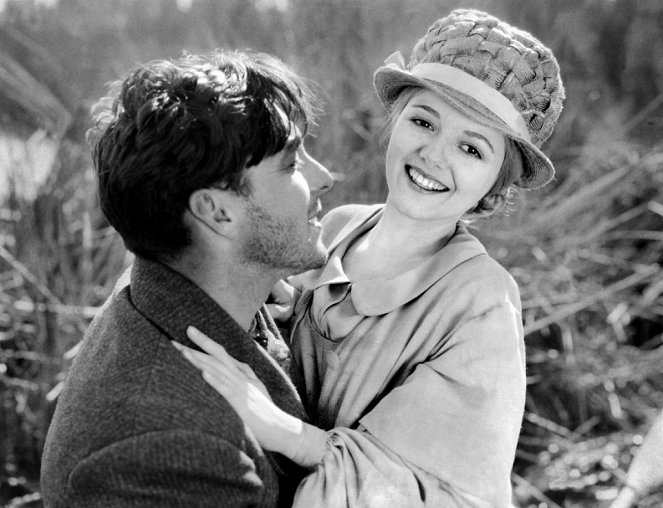
Early and later sound romantic films
One of the first romantic films of the sound era was the partially spoken Lonesome (1928), about a chance meeting of two young people who spend a day together. From the early 1930s onwards, the most popular romantic films were those starring Greta Garbo, including Romance (1930), Queen Christina (1933), Anna Karenina (1935), Camille (1936) and Ninotchka (1939), in which she played a Russian commissary who falls in love with a Parisian aristocrat. Romantic musicals were also popular, including The Love Parade (1929), The Smiling Lieutenant (1931), Dancing Lady (1933), The Merry Widow (1934), Top Hat (1935), Swing Time (1936), Shall We Dance? (1937), Alexander’s Ragtime Band (1938) and Carefree (1938), where a couple of feuding fiancés decide to address their relationship problems with the help of a psychiatrist, inadvertently giving rise to a love triangle. Other successful films included Break of Hearts (1935), in which the fates of a philandering conductor and a shy composer are rocked by love, and Love Affair (1939), about the spark between two individuals engaged to different partners on board a luxury liner. Historical romances based on famous novels and plays were also common, such as Little Women (1933) and Romeo and Juliet (1936), both directed by George Cukor, and William Wyler's Wuthering Heights (1939). However, the most successful in this respect by far was the monumental narrative masterpiece Gone with the Wind (1939), an eight Oscar-winning historical romance starring Vivien Leigh and Clark Gable, set during the American Civil War and the reconstruction of the defeated South.
By contrast, the most successful romantic film of the 1940s was Michael Curtiz's Casablanca (1942), starring Humphrey Bogart and Ingrid Bergman, which took in three of its eight Oscar nominations and was set on the neutral ground of a nightclub in the Moroccan capital during World War II. William Wyler's post-war film The Best Years of Our Lives (1946) won seven Oscars with its story about the lives of several men trying to reintegrate into society after returning from the army. The Heiress (1949), from the same director, took in four golden statuettes with a story about the romance of a girl with a poor young man that causes a rift with her father. Also worth mentioning is the romantic comedy The Shop Around the Corner (1940), in which two feuding employees begin to correspond amorously in response to an advertisement, without knowing who they are really writing to. It was followed by the romantic dramas Letter from an Unknown Woman (1948) and Little Women (1949) and the romantic musicals You'll Never Get Rich (1941), You Were Never Lovelier (1942), Cover Girl (1944), Meet Me in St. Louis (1944) and Easter Parade (1948).
Gone with the Wind (1939)
Photo © Warner Bros. Pictures
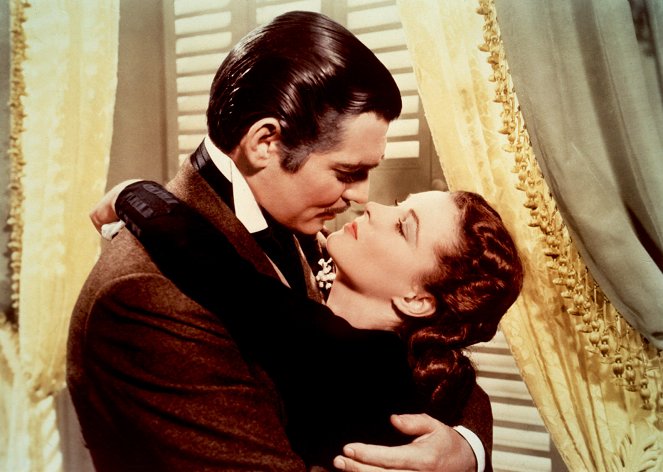
Screwball romantic comedies of the 1930s and 40s
The term "screwball comedies" refers to a specific sub-genre of romantic comedies that have been made in Hollywood since the Great Depression, whose aim was to give audiences a few moments of respite from the economic and social hardships society as a whole was suffering. They were dialogue comedies that poked fun at traditional romantic stories and emphasized creative humorous conversation instead of the mutual love of the two protagonists – the relationship between a man and a woman often resembled a verbal duel of eloquence and wit, using ambiguous sexual innuendo instead of intimate physical contact, which was forbidden by censorship at the time. 1930 saw the establishment of the Production Code, a set of moral rules and guidelines according to which certain things and expressions were undesirable for cinema screens. This resulted in flirting and seduction being largely replaced by verbal bickering, which nevertheless usually culminated in the standard way of expressing mutual affection and marriage. The protagonists were usually self-confident, stubborn and cunning, often from different social classes, which served to thematise the clash between the working middle class (typically male) and the elite (typically female). Other traditional motifs included playing with disguises and fake roles, building up unlikely comic situations and extremely fast speech.
This sub-genre began with films such as The Patsy (1928), The Front Page (1931) and Bombshell (1933), but Frank Capra's It Happened One Night (1934) is considered its definitive founder, which, for its romantic tale of a millionaire's daughter and a down-and-out journalist, was the first film in history to win all five Academy Awards in the major categories: Best Picture, Best Director, Best Screenplay, and for the performances of Claudette Colbert and Clark Gable in the lead roles. In addition to Colbert and Gable, Katharine Hepburn, Cary Grant, Spencer Tracy, Irene Dunne, James Stewart, Barbara Stanwyck and William Powell also became stars of screwball romantic comedies. My Man Godfrey (1936), about a bum in the employ of an eccentric millionaire family, was nominated for six Oscars, and the romantic comedy You Can't Do It with You (1938), about fiancés struggling with their fundamentally different families, turned in two of its seven Oscar nominations. Libeled Lady (1936) revolved around crazy situations caused by false gossip, Bringing Up Baby (1938) enriched the absurd plot about the search for a dinosaur bone with an even more absurd chase of a tame leopard, and in the comedy Ball of Fire (1941), a linguist in love unwittingly gets involved with the Mafia. Also worth mentioning are the romantic comedies Holiday (1938), The Mad Miss Manton (1938), The Palm Beach Story (1942), The More the Merrier (1943), and Adam's Rib (1949), whose protagonists were a married couple of lawyers who become adversaries in a court case.
The same genre also included romantic comedies thematising the breakdown of a relationship and its renewal, which could take the form of a divorce and the subsequent remarriage of the partners – with their temporary separation bringing fresh energy, newfound trust and a desire for intimacy back into the union. Typical representatives were, for instance, The Awful Truth (1937), a film by Leo McCarey about divorcing spouses, Garson Kanin's comedy My Favourite Wife (1940), in which a newly married man is confronted with his previous wife, whom he considered deceased, George Cukor's The Philadelphia Story (1940), about a divorced tabloid journalist battling for his ex-wife's heart with two other suitors, and Howard Hawks's His Girl Friday (1940), in which a newspaper editor tries to win back his former wife, a reporter engaged to another man. In Preston Sturges's The Lady Eve (1941), the protagonists reversed their usual roles and left it to the woman to upstage the indifferent man, and in Alfred Hitchcock's comedy Mr. & Mrs. Smith (1941) a married couple learns that their marriage has been invalid the whole time due to a legal error. George Stevens's relationship film Woman of the Year (1942) followed the emotional outbursts, arguments and final reconciliation of a sportswriter and an international journalist.
Bringing Up Baby (1938)
Photo © RKO Radio Pictures
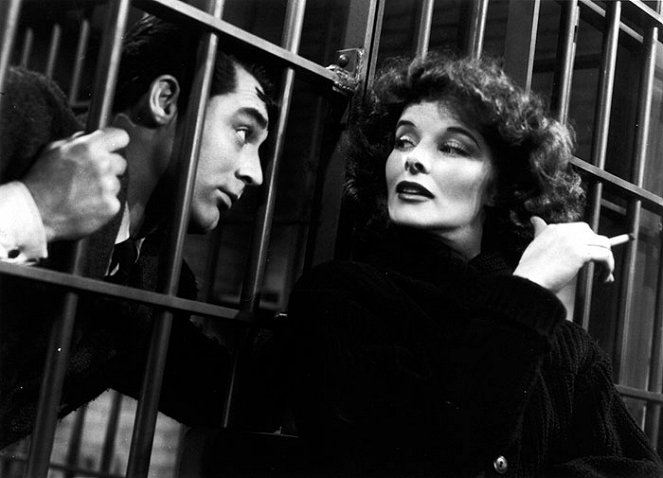
Romantic films of the 1950s
The biggest star of the romantic films of the 1950s and early 60s was Audrey Hepburn, many of whose films became worldwide classics. She was awarded an Oscar in 1954 for William Wyler's Roman Holiday, which took in three of its ten nominations for the golden statuette with the story of a young princess who is guided around the Italian capital by an American journalist with whom, despite their mutual infatuation, she can never end up with due to her social status. Hepburn went on to star in Billy Wilder's romantic comedies Sabrina (1954) and Love in the Afternoon (1957), and in the romantic musical Funny Face (1957). Another classic in her career was the seven Oscar-nominated Breakfast at Tiffany's by Blake Edwards (1961), whose heroine represented the social atmosphere of the time, especially the light-hearted exuberance, celebration and enjoyment of life. She would later star in the romantic thriller Charade (1963), the eight-Oscar-winning musical My Fair Lady (1964) and the romantic road-movie Two for the Road (1967).
Musicals have also been among the most successful films of the romantic genre, from An American in Paris (1951), starring a painter in love with a young French woman engaged to a cabaret singer, to Singin' in the Rain (1952), a playful romantic satire of Hollywood in the early days of sound film, to the wartime musical romance South Pacific (1958), set during the Pacific War. Other classics of the genre include The African Queen (1951), an adventurous romance between an English lady and a drunken captain in the Congo jungle, the six Oscar-winning A Place in the Sun (1951), the eight Oscar-winning war romance From Here to Eternity (1953), and An Affair to Remember (1957), a remake of the 1939 film Love Affair. Other productions worth mention include the British romantic films The Million Pound Note (1954), Summertime (1955) and Indiscreet (1958), the co-produced Shakespearean adaptations Othello (1952) and Romeo and Juliet (1954), and the Walt Disney animated fairy tales Cinderella (1950) and Lady and the Tramp (1955).
Roman Holiday (1953)
Photo © Paramount Pictures
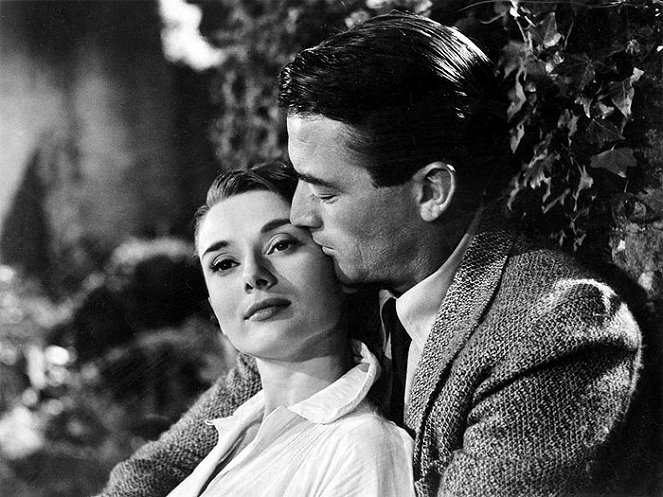
Sexual comedies of the 1950s and 60s
While the screwball romantic comedies of the 1930s and 40s were virtually silent on sexual and intimate themes and replaced them with snappy witty conversations and innocent double entendres, that was not the case for the romantic comedies produced in the 1950s; for the first time, things that had been forbidden by the Production Code in previous decades were heard on screen. 1953 is often referred to as a turning point in this respect, when Otto Preminger's comedy of manners The Moon Is Blue premiered, despite objections and trials with the censors, dealing with the story of a sincere young actress who spends an evening with her two suitors discussing the moral problems in society at the time. Usually, the plots of sexual romantic comedies revolved around seductive women contemplating marriage and womanizing men with ulterior motives trying to win their trust, which they often achieved through deceit and pretence (though they often ended in reconciliation, sincere declarations of love and marriage anyway).
Marilyn Monroe (Gentlemen Prefer Blondes, 1953, How to Marry a Millionaire, 1953, and Let’s Make Love, 1960) and Doris Day (Lover Come Back, 1961, That Touch of Mink, 1962) became famous stars of this sub-genre. The most successful in this regard were Billy Wilder's romantic comedies starring Marilyn Monroe The Seven Year Itch (1955), in which a married man spends lonely evenings with a naive and irresistible neighbour, and Some Like It Hot (1959), the six-Oscar-nominated story of two musicians who, on the run from gangsters, disguise themselves as women and hide out in an all-girl orchestra. Billy Wilder went on to make romantic comedies with Jack Lemmon and Shirley MacLaine, for example, The Apartment (1960), a five-Oscar-winning film about a clerk who lends his apartment to colleagues to meet lovers, and Irma La Douce (1963), about a Parisian prostitute with whom a former policeman falls in love. Pillow Talk (1959), a Michael Gordon's comedy starring Doris Day and Rock Hudson, took in one of its five Oscar nominations with its story of a man who seduced women through various deceptions and then, disguised as a rich Texan, becomes interested in a reclusive designer with whom he shares a phone line and who thinks he is a sex maniac. But the sexual revolution of the second half of the 1960s would introduce new trends in the USA, and romantic comedies in which women were mere prey soon fell out of favour.
The Apartment (1960)
Photo © United Artists
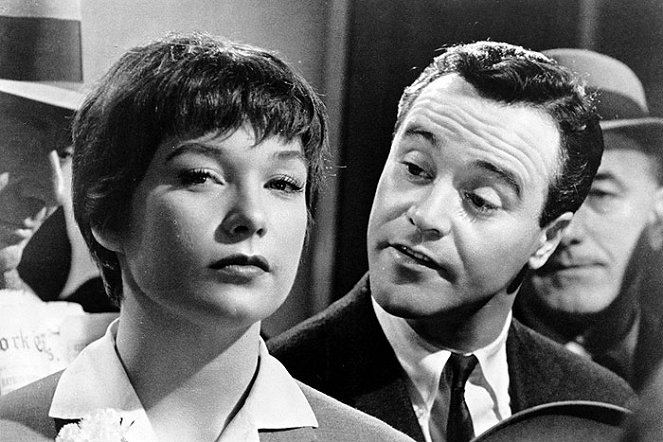
Other romantic films of the 1960s
Robert Wise and Jerome Robbins' ten Oscar-winning musical West Side Story (1961), based on Shakespeare's tragedy Romeo and Juliet but set in modern New York, was a huge success. The same play would later receive a classic adaptation in the form of Romeo and Juliet (1968), whose director, Franco Zeffirelli, already had experience with Shakespearean material when making The Taming of the Shrew (1967). Stanley Kubrick's romantic drama Lolita (1962) and John Schlesinger's Far from the Madding Crowd (1967) were also based on famous novels. In contrast, the romantic comedies Barefoot in the Park (1967) and Cactus Flower (1969) were based on plays. There were two films that became huge events, Cleopatra (1963), a three-Oscar-winning pompous historical romance starring Elizabeth Taylor as the famous Egyptian ruler, and David Lean's five-Oscar-winning Doctor Zhivago (1965), the love story of a married doctor and a married aristocrat against the backdrop of World War I and the Russian Civil War.
Stanley Kramer's Guess Who's Coming to Dinner (1967), a ten Oscar-nominated conversational film in which a white married couple had to deal with their daughter's black boyfriend, was very progressive for its time. Also worth mention are the romantic comedy musicals What a Way to Go! (1964) and Hello, Dolly! (1969), as well as Come September (1961) and Splendor in the Grass (1961). A long-running phenomenon in Europe at the time was a co-produced French series of historical romance films starring Michèle Mercier and Robert Hossein, telling the story of a noblewoman married to a wealthy count, consisting of Angelique (1964), Angelique: The Road to Versailles (1965), Angelique and the King (1966), Indomptable Angelique (1967) and Angelique and the Sultan (1968). Other purely European productions of the 1960s worth mention include the Italian romantic films Yesterday, Today and Tomorrow (1963) and Marriage Italian Style (1964), the French Jules and Jim (1962) a Stolen Kisses (1968), and the Czechoslovak Loves of a Blonde (1965).
Romeo and Juliet (1968)
Photo © Paramount Pictures
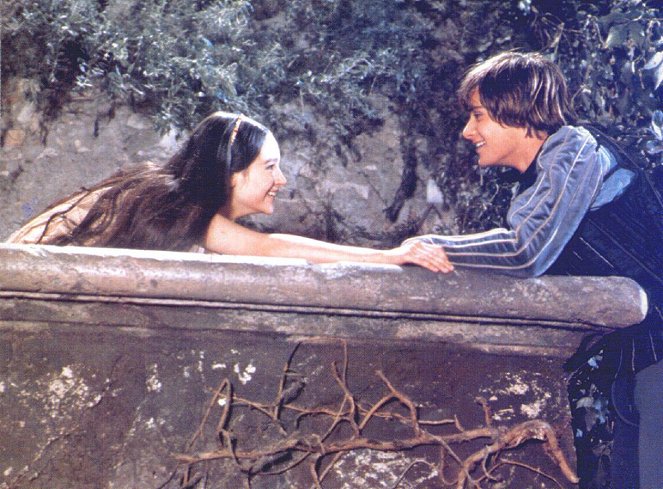
The decline of romantic comedies in the 1970s and 80s
The changes in Hollywood in the second half of the 1960s spilled over into the filmmaking of the following decade – the new generation of filmmakers no longer adhered to fixed genre templates and instead came up with new themes and techniques, while the abolition of the Production Code also contributed to the opening up of new themes. In 1967, Mike Nichols's The Graduate, a romantic comedy drama nominated for seven Academy Awards, was a huge success starring Dustin Hoffman as a college student who begins a secret love affair with an older married woman only to fall in love with her daughter. At the end of the film, a wedding is crashed at the last moment and the young couple escapes from the party, but the embarrassment and uncertainty on their faces, implies that there was no happy ending – it was more a film polemicising the romantic genre and its formulas. Similarly controversial later were the black romantic comedy such as A New Leaf (1971), whose impoverished protagonist chooses to marry a wealthy heiress for her fortune, planning to kill her at the appropriate moment, and Woody Allen's four-Oscar-winning romantic comedy Annie Hall (1977), in which the central couple goes through the courtship process while, paradoxically, constantly debating the absurdity of relationships and the impossibility of true love.
Generally speaking, the romantic genre of the classical type was on the decline in the 1970s, and even in the first half of the 1980s and, with a few exceptions, it did not cause a very significant response. Only a few films followed the familiar templates, such as the four Oscar-nominated Same Time, Next Year (1978) and Billy Wilder’s comedies Avanti! (1972) and The Front Page (1974). Other films, by contrast, broke the mould: Harold and Maude (1971), for example, was a rather unconventional romance in this respect, telling the story of the friendship between a twenty-year-old young man obsessed with dead and an energetic eighty-year-old woman. Another unconventional romantic hero was the bespectacled film critic played by Woody Allen in Play It Again, Sam (1972), whose dialogue revolved largely around relationship and sexual peripeteia, and was also a demythologizing homage to Casablanca. After Annie Hall, Woody Allen would tackle the romantic genre again in Manhattan (1979), The Purple Rose of Cairo (1985) and Hannah and Her Sisters (1986). Sydney Pollack's Tootsie (1982), starring Dustin Hoffman as an overlooked actor who decides to try his luck disguising himself as a woman, was nominated for nine Oscars, while in Ron Howard's fantasy film Splash (1984), the main character played by Tom Hanks falls in love with a mermaid.
In the second half of the 1980s, Baby Boom (1987), a comedy starring Diane Keaton, was quite successful, and was followed by the three Oscar-winning Moonstruck (1987), the seven Oscar-nominated Broadcast News by James L. Brooks (1987), the six Oscar-nominated Working Girl by Mike Nichols (1988), Coming to America with Eddie Murphy (1988), and Cameron Crowe's high school romance Say Anything... (1989). The screwball romantic comedies of the 1930s and 40s were echoed in What's Up, Doc? (1972), Something Wild (1986) and Garry Marshall's Overboard (1987), in which a simple carpenter convinces a rich woman with memory loss that she is his wife. A big hit at the time was Rob Reiner's romantic comedy When Harry Met Sally... (1989), which interspersed conversations about relationships and sex and the story of two characters played by Meg Ryan and Billy Crystal who, over the course of a few chance encounters, make their way from opposing strangers to intimate friends to a loving couple.
Harold and Maude (1971)
Photo © Paramount Pictures
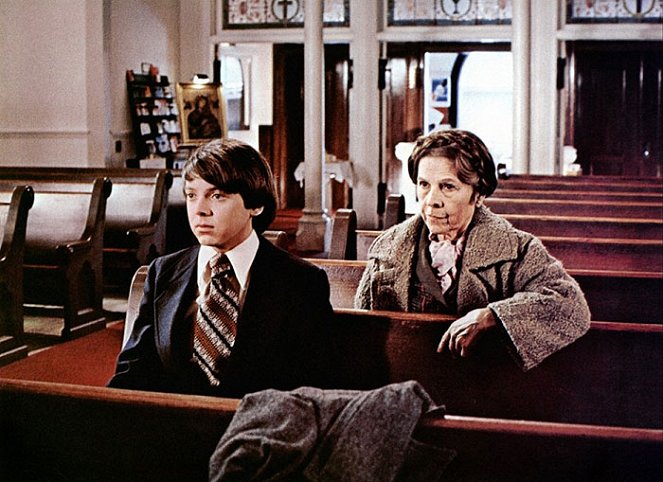
Other romantic films of the 1970s and 80s
In the midst of an atmosphere of turmoil and conflict, Arthur Hiller's Love Story, a kind and sensitive film, entered cinemas in 1970, capturing the spirit and filmmaking techniques of the time and transforming its serious social problems into a sober and classically conceived romance between two young people from different class backgrounds. It was a poignantly sad film that became an audience hit and a model for many later heart-warming romantic dramas. Bernardo Bertolucci's love drama Last Tango in Paris (1972) caused a considerable response and a wave of controversy due to its sexual openness. Eight Oscars went to Bob Fosse's Cabaret (1972), which explored the love affairs of several characters against the backdrop of emerging fascism in 1930s Berlin. The musical Grease (1978), starring John Travolta and Olivia Newton-John, was a huge hit, nostalgically harking back to the 1950s, with songs that have enjoyed long-lasting popularity. Other films of note include Martin Scorsese's musical romantic drama New York, New York (1977), about the complicated love affair between a jazz saxophonist and a pop singer, and Hal Ashby's eight Oscar-nominated anti-war romance Coming Home (1978), which told the story of a soldier whose wife falls in love with a disabled war veteran after his departure for the Vietnam War.
In the 1980s, the romantic genre was especially successful at the Oscars with James L. Brooks's Terms of Endearment (1983), which dealt with the relationships of a mother and a daughter, and Sydney Pollack's Out of Africa (1985), starring Meryl Streep and Robert Redford as a loving couple consisting of a coffee plantation owner and a charismatic hunter. Also successful in the battle for the golden statuettes were Yentl (1983), directed by and starring Barbra Streisand as a woman who, in her desire to study religion pretends to be a man, Children of a Lesser God (1986) by Rand Haines, which told the love story of a teacher and a former pupil at a boarding school for the deaf, and Dangerous Liaisons by Stephen Frears (1988), an adaptation of a historical novel about a viscount and a marquess who liked to play with other people's feelings. A major audience hit was Dirty Dancing (1987), in which Patrick Swayze and Jennifer Grey took on the roles of a dance instructor and a girl from a conservative family who unexpectedly becomes his partner for an important performance. Also worth mention are Falling in Love (1984), the French The Big Blue (1988), and Steel Magnolias (1989), as well as some romantic films falling into other genres, such as sci-fi (Starman, 1984), adventure (Romancing the Stone, 1984), fairytale fantasy (Ladyhawke, 1985, The Princess Bride, 1987) and animated (The Little Mermaid, 1989).
Grease (1978)
Photo © 1978 Paramount Pictures
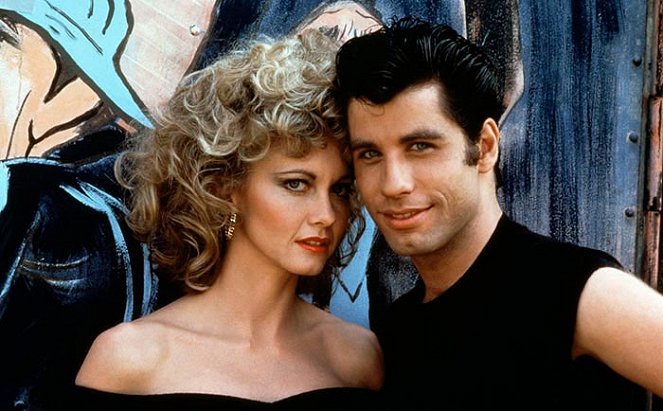
Romantic films of the 1990s
The biggest box-office romantic hits of the 1990s were Jerry Zucker's Ghost (1990), a two-Oscar-winning story starring Patrick Swayze and Demi Moore as a tragically deceased clerk and his partner whom he tries to contact from beyond the grave, and James Cameron's eleven-Oscar-winning Titanic (1997), which, in addition to the sinking of the famous liner, told the story of the love between two young people from different social classes, played by Leonardo DiCaprio and Kate Winslet, and for a many years would hold the record of the highest-grossing film of all time. Other films that succeeded at the Oscars include The English Patient by Anthony Minghella (1996), a romantic war drama about a wounded soldier telling his nurse about his memories of the Second World War, James L. Brooks's comedy As Good as It Gets (1997), about the relationship between a choleric curmudgeon and his favourite waitress, played by Jack Nicholson and Helen Hunt, and John Madden's Shakespeare in Love (1998), about the love between the famous London playwright and his muse. Another film that received a major audience response was Mick Jackson's The Bodyguard (1992), starring Whitney Houston and Kevin Costner, depicting the story of a famous singer and her bodyguard.
The colour of skin was the subject of Spike Lee's activist romantic drama Jungle Fever (1991), in which a married African-American architect becomes involved with his Italian-American secretary. Robert Mulligan's The Man in the Moon (1991) was a coming-of-age film, Kevin Smith's comedy film Chasing Amy (1997) focused on lesbian themes, and Martin Brest's Meet Joe Black (1998) proved how the power of love between the main characters played by Claire Forlani and Brad Pitt can conquer even Death itself, incarnated in one of them. In Brad Silberling's City of Angels (1998), a loose remake of Wim Wenders's German film Wings of Desire (1987), one of the main characters is an angel in love, while Tim Burton's Edward Scissorhands (1990) offered an even stranger protagonist in the form of an artificial man with sharp blades instead of hands. Martin Scorsese's The Age of Innocence (1993), Gillian Armstrong's Little Women (1994), Ang Lee's Sense and Sensibility (1995), Douglas McGrath's Emma (1996), Joel Schumacher's Dying Young (1991), Roman Polanski's Bitter Moon (1992), Clint Eastwood's The Bridges of Madison County (1995) and Adrian Lyne's Lolita (1997), among others, were all based on famous novels.
In 1993, the Oscar for Best Non-English Language Film went to the French wartime romantic drama Indochine (1992), the story of a rubber plantation owner in colonial Vietnam who falls in love with a French soldier, who in turn falls in love with her adopted daughter. Significant attention was also drawn to Hong Kong romantic films by director Kar-wai Wong, especially Chungking Express (1994), Fallen Angels (1995), Happy Together (1997) and In the Mood for Love (2000), depicting the story of the illegitimate love of two people whose partners spent a lot of time travelling for work and had no choice but to spend lonely evenings in a shared apartment. Before Sunrise (1995), a romantic conversational drama starring Ethan Hawke and Julie Delpy, was the start of a remarkable experiment, in which director Richard Linklater focused on a chance encounter between two people and their day together, and then returned to the same characters with the same actors in Before Sunset (2004) and Before Midnight (2013), capturing their subsequent lives at regular intervals, including their real ageing. In the hands of director Baz Luhrmann, Romeo + Juliet (1996) became a modernized adaptation of Shakespeare's famous tragedy, while Much Ado About Nothing (1993), Twelfth Night: Or What You Will (1996) and A Midsummer Night’s Dream (1999) also drew on from his comedies.
Ghost (1990)
Photo © Paramount Pictures
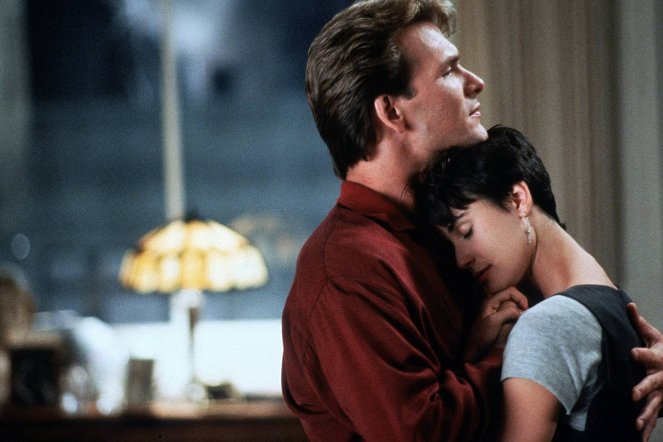
The renaissance of romantic comedies in the 1990s
The success of the aforementioned When Harry Met Sally... (1989) led in the early 1990s to a resurgence in the popularity of romantic comedies. They were mostly free of the conversations about sex popular in the 1970s and 1980s, and instead returned to older, tried-and-true genre templates. Garry Marshall's Pretty Woman (1990) was a huge hit with its story of the love between a prostitute and a millionaire businessman that used the clash of two people from completely different social classes, and turned Julia Roberts and Richard Gere into stars of the romantic genre. In fact, films starring Julia Roberts would be among the most profitable romantic films of the second half of this decade. For instance, My Best Friend's Wedding (1997), in which she tries to woo her former partner engaged to another woman, Notting Hill (1999), in which an ordinary bookseller, played by Hugh Grant, falls in love with her as a movie star, and Runaway Bride (1999), in which she was reunited with Richard Gere as a woman repeatedly running away from her fiancé from the altar.
One key figure in the final form of Notting Hill was British screenwriter and later director Richard Curtis, who brought dry English humour, clumsy protagonists and quirky supporting characters to romantic comedies – for example, in Mike Newell's Four Weddings and a Funeral (1994). Compared to the previous decades, the 1990s were also characterised by the more frequent portrayal of romantic comedy heroines as independent, emancipated women who are building their careers while dealing with relationship problems. For example, in One Fine Day (1996) Michelle Pfeiffer plays an architect who is also single mother, in Picture Perfect (1997) Jennifer Aniston plays an aspiring ad agency agent looking for career advancement, and in What Women Want (2000) Helen Hunt is the manager and the boss of the protagonist who one day begins to hear the thoughts of the women around him.
Julia Roberts's biggest competition in romantic comedies at the time was Meg Ryan, who shone in the 1990s in films such as I.Q. (1994), in which she is matchmaked by Albert Einstein himself, French Kiss (1995), in which she meets a charming con man while on a trip to Paris to meet her lover, and Addicted to Love (1997), in which she copes with the end of a relationship. Her most famous romantic comedies from this period, however, were those in which she was partnered by Tom Hanks; first in Joe Versus the Volcano (1990) and then a pair of films by director and screenwriter Nora Ephron: Sleepless in Seattle (1993), in which they arrange a blind date on Valentine's Day, and You've Got Mail (1998), in which they portray two professional rivals who anonymously send love messages to each other on the internet, without knowing who the recipient really is. Sandra Bullock was also often cast in romantic comedies, for example, in Practical Magic (1998) and Forces of Nature (1999), while in While You Were Sleeping (1995) she finds of the ideal partner, but after fulfilling her dream she realises that true love was waiting for her somewhere else. Other popular actresses of romantic comedies include Drew Barrymore (The Wedding Singer, 1998, Never Been Kissed, 1999), Andie MacDowell (Green Card, 1990, Groundhog Day, 1993), Cameron Diaz (There’s Something About Mary, 1998) and Julia Stiles (10 Things I Hate About You, 1999).
Four Weddings and a Funeral (1994)
Photo © Gramercy Pictures
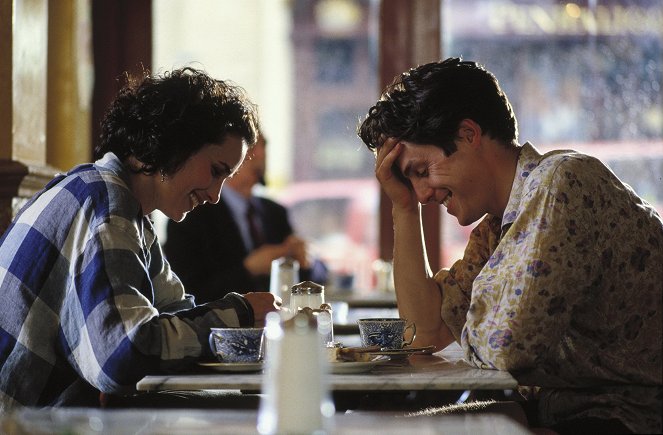
Romantic films of the new millennium
After 2000, the French romantic film Amelie (2001) became an international sensation, starring Audrey Tautou as a waitress who decides to help people find happiness. Another extremely popular film was Baz Luhrmann's eight Oscar-nominated musical Moulin Rouge! (2001), whose plot about the love between a poet and a Parisian courtesan was interspersed with excerpts from famous songs of past decades. Later, the hugely successful romantic musical La La Land (2016), took in six of its thirteen Oscar nominations with its story about a lovelorn couple played by Emma Stone and Ryan Gosling confronting ambitious dreams and harsh realities, and which its director Damien Chazelle conceived as an homage to the musicals of the classic Hollywood era. The Artist (2011), which won five Oscars, was another tribute to Hollywood, this time to the end of the silent era. Even deeper into the past were the historical romances Cold Mountain from 2003 (American Civil War), Girl with a Pearl Earring from 2003 (17th century) and The Other Boleyn Girl from 2008 (16th century).
There have been some romantic dramas that addressed homosexual relationships. For example, the three Oscar-winning Brokeback Mountain (2005), God's Own Country (2017) and Call Me by Your Name (2017) dealt with gay men cautiously coming together, while Blue Is the Warmest Colour (2013), Carol (2015), Portrait of a Lady on Fire (2019) and Ammonite (2020) focused on lesbian themes. There was also an increase in the number of romantic films dealing with serious medical or mental conditions or the fatal illness of one or both of the main characters, whether it was leukaemia (A Walk to Remember, 2002, Now Is Good, 2012), Alzheimer's disease (The Notebook and A Moment to Remember, both 2004), Asperger's syndrome (Adam, 2009), Parkinson's disease (Love and Other Drugs, 2010), manic depression (Silver Linings Playbook, 2012), sudden memory loss (The Vow, 2012), stroke (Amour, 2012), cancer (2011's 50/50, 2014's The Fault in Our Stars), paralysis (2016's Me Before You, 2017's Breathe), and sunlight allergy (2018's Midnight Sun).
Director Joe Wright revived romantic adaptations of classic novels with Keira Knightley and the films Pride & Prejudice (2005), Atonement (2007) and Anna Karenina (2012), which were followed by, among others, Andrea Arnold's Wuthering Heights (2011), Cary Fukunaga's Jane Eyre (2011), and Baz Luhrmann's The Great Gatsby (2013). Other films based on books were Thomas Vinterberg's Far from the Madding Crowd (2015), Brooklyn (2015), The Light Between Oceans (2016), and Little Women (2019), which shared with Wright's Atonement their postmodern meta-fictional conclusion. Some South Korean romantic films also became extremely popular, for example, My Sassy Girl (2001), Classic (2003), Daisy (2006), Castaway on the Moon (2009), The Beauty Inside (2014) and the romantic thriller The Handmaiden (2016).
La La Land (2016)
Photo © Lionsgate
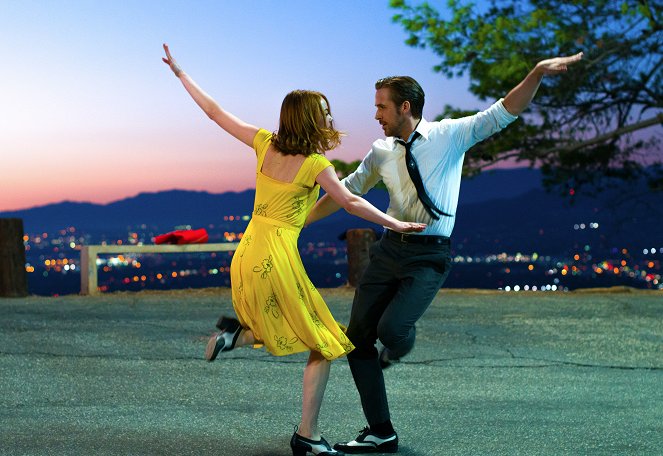
Unconventional romantic films after 2000
Many romantic films enriched their plots with unconventional or fantasy elements. For example, in Eternal Sunshine of the Spotless Mind (2004) the protagonist had the memories of his ex-girlfriend erased, the protagonists of The Lake House (2006) communicated across time, and the sci-fi romance I Origins (2014) worked with the motif of reincarnation. In The Curious Case of Benjamin Button (2008), nominated for thirteen Oscars, a couple in love struggles with the opposite aging of one of them, while in the fantasy drama The Age of Adaline (2015), the main character's aging process is completely interrupted. There were also romantic war films (Pearl Harbor, 2001, Australia, 2008, and Allied, 2016), musicals (A Star Is Born, 2018), erotic films (Secretary, 2002, Fifty Shades of Grey, 2015) and fairytales, both live-action (Cinderella, 2015, Beauty and the Beast, 2017) and animated (Corpse Bride, 2005, and Tangled, 2010).
Filmed in three versions, The Disappearance of Eleanor Rigby (2013 and 2014) told the same story from two different perspectives. The characters in Phantom Thread (2017) built their unusual romantic relationship between a fashion designer and his muse on complete devotion and unhealthy dependence and obsession. Some films were distinguished by their unusual settings, whether exotic (Memoirs of a Geisha, 2005, The Painted Veil, 2006) and outer space (Passengers, 2016), and others by their unconventional protagonist; for example, the protagonist of the fairytale Stardust (2007) falls in love with a fallen star, Her (2013) dealt with the relationship between a man and an artificial intelligence operating system, and The Shape of Water (2017), which took in four out of its thirteen Oscar nominations, dealt with the strange romance between a mute cleaning lady and an amphibious monster. The greatest phenomenon in this respect, however, was Twilight (2008), whose story of the love between a high school student and a vampire gave rise to a hugely popular fantasy film series.
Phantom Thread (2017)
Photo © Focus Features
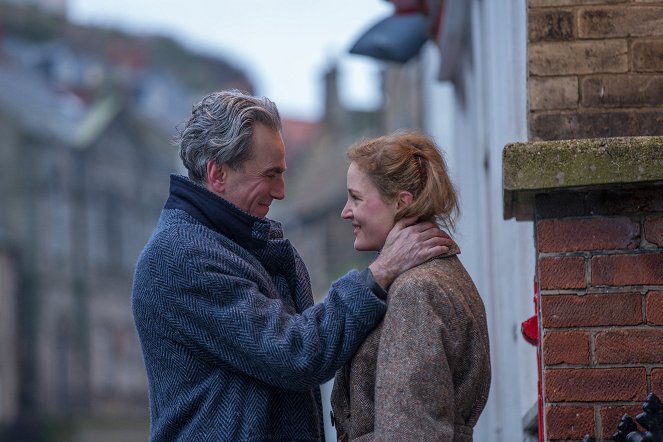
The faces of romantic comedies in the 21st century
In terms of romantic comedies, the beginning of the new millennium was marked by big British hits in the form of Sharon Maguire's Bridget Jones's Diary (2001), starring Renée Zellweger as a woman in her thirties with extra kilograms and a lack of self-confidence struggling to find a partner, and Richard Curtis's star-studded Love Actually (2003), which eventually became a Christmas romantic classic. Some of the actresses established in the romantic genre from the previous decade continued to be stars, notably Jennifer Aniston (2006's The Break-Up, 2010's The Switch), Sandra Bullock (2002's Two Weeks Notice, 2009's The Proposal), Cameron Diaz (2006's The Holiday, 2008's What Happens in Vegas) and Drew Barrymore (2004's 50 First Dates), while the actors who stayed relevant include Hugh Grant (2002's About a Boy, 2007's Music and Lyrics), Ben Stiller (2000's Keeping the Faith, 2004's Along Came Polly) and Adam Sandler (2002's Punch-Drunk Love, 2004's Spanglish).
But new faces gradually began to join the old friends; for example, Reese Witherspoon (2001's Legally Blonde), Anne Hathaway (2001's The Princess Diaries), Sarah Jessica Parker (2008's Sex and the City), Jennifer Lopez (2001's The Wedding Planner), Kirsten Dunst (2004's Wimbledon), Katherine Heigl (2009's The Ugly Truth), Mila Kunis (2011's Friends with Benefits), and Emma Stone (Crazy, Stupid, Love., 2011). The men who made it in romantic comedies include John Cusack (Serendipity, 2001), Matthew McConaughey (How to Lose a Guy in 10 Days, 2003) and Ashton Kutcher (No Strings Attached, 2011).
Love Actually (2003)
Photo © 2003 Universal Pictures
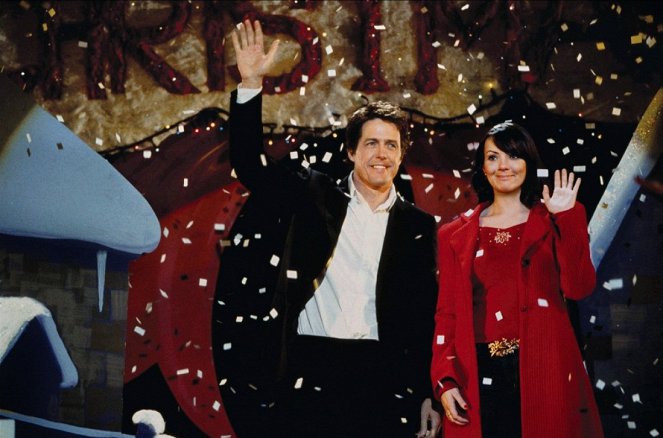
Unconventional romantic comedies after 2000 and genre fatigue
As the model of the classical romantic comedy began to exhaust itself, many filmmakers attempted to revive it with a rather unfamiliar premises or themes. Huge hits included My Big Fat Greek Wedding (2002), which drew on cultural differences between lovers, the comedy Knocked Up (2007), which revolved around an unwanted pregnancy, and the musical romance Mamma Mia! (2008), which featured songs by ABBA. Kate & Leopold (2001) and Midnight in Paris (2011) dealt with time travel, Just Like Heaven (2005) had the protagonist falling in love with the ghost of a deceased tenant, and the comedy Penelope (2006) enriched the romantic plot with fairytale elements. Innovations also included working with retro styling (Peyton Reed's Down with Love from 2003), finding new levels of vulgarity and sexual limits (Kevin Smith's Zack and Miri Make a Porno from 2008), or telling the love affairs of older generations, like, for example, Nancy Meyers's Something's Gotta Give (2003) and It's Complicated (2009).
Aside from genre conventions, many romantic comedies tinkered with the concept of the protagonist. In Forgetting Sarah Marshall (2008) the protagonist is an extremely sensitive individual, in 500 Days of Summer (2009) it is a dreamer who falls in love with a cynical woman who fundamentally refuses to believe in the existence of love, and in the pop culture-laden comedy Scott Pilgrim vs. the World (2010), it is a geek who has to fight for his chosen one with her previous boyfriends. Also popular were romantic comedies of the "bromance" type, i.e. films fulfilling certain romantic schemes but focusing on the friendship of two men, such as Wedding Crashers (2005), Superbad (2007) and I Love You, Man (2009).
In later years, however, the romantic comedy was on the wane and only the truly unconventional ones, such as those combined with an action film (This Means War, 2012), a fantasy theme about time travel (About Time, 2013), horror (Warm Bodies, 2013), a homosexual plot (Love, Simon, 2018) or a Christmas theme (Last Christmas, 2019), had a significant impact. Other popular films include Ruby Sparks (2012), in which the fictional heroine of romance novels magically comes to life before the eyes of its young writer, The Big Sick (2017), inspired by a real-life romance between an American and a Pakistani, Yesterday (2019), set in an alternate world where the Beatles never existed, and Palm Springs (2020), which explores the paradoxes of the time loop.
(500) Days of Summer (2009)
Photo © Fox Searchlight Pictures
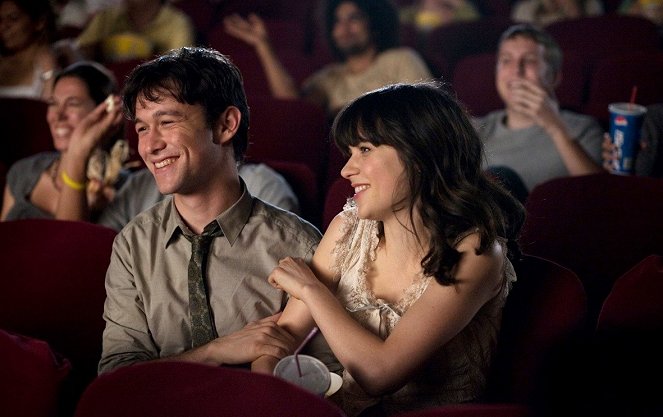
Romantic TV series, sitcoms, soap operas and telenovelas
In the early days of television, romantic series often took the form of soap operas, i.e. relationship series with simple romantic or melodramatic stories, some of which were broadcast for several decades, giving rise to the term "endless series". Their episodes built on each other, took place in the same settings, and over the years featured many characters, most often connected by family, friendship or work ties. The longest-running ones include The Guiding Light (1952-2009), As the World Turns (1956-2010), Coronation Street (since 1960), General Hospital (since 1963), Days of Our Lives (since 1965), All my Children (1970-2011), The Young and the Restless (since 1973) and The Bold and the Beautiful (since 1987). Other popular long-running series included The Love Boat (1977-1987), which dealt with the romances of passengers on a luxury cruise ship, Dallas (1978-1991), which revolved around the wealthy members of the family of the founder of an oil company, and Falcon Crest (1981-1990), which focused on a family with a wine estate.
In contrast, more artistically worthy were, for example, the British television miniseries and serials based on Jane Austen's novels, which existed already in the 1950s (when two versions of Pride and Prejudice were made, in 1952 and 1958). This trend continued to be popular on television in the 1960s and 70s (1967's Pride and Prejudice, 1971's Persuasion, and 1972's Emma) and carried on in later decades (Pride and Prejudice, 1980 and 1995, Mansfield Park 1983, Sense and Sensibility, 2008, Emma, 2009).
The 1990s saw the creation of several series that used the soap opera formula, but were aimed mainly at young and teenage viewers. Pioneering in this regard was Beverly Hills, 90210 (1990-2000), whose protagonists were attractive high school students from wealthy families who experienced first loves, breakups and other events together. Other series based on a similar principle include Melrose Place (1992-1999) and That '70s Show (1998-2006), which, in addition to the school setting, was also based on retro styling, and were later followed by The O.C. (2003-2007) and Gossip Girl (2007-2012). In the 1990s there were also many telenovelas (the Latin American equivalent of soap operas), especially from Venezuela (Kassandra, 1992), Argentina (Wild Angel, 1998-1999) and Mexico (Esmeralda, 1997, Rosalinda, 1999, and When You Are Mine, 2001-2002). Some sitcoms also dealt with relationship and partner issues, most notably Friends (1994-2004) and Sex and the City (1998-2004), and later ones such as How I Met Your Mother (2005-2014), The Big Bang Theory (2007-2019) and Modern Family (2009-2020), while The Gilmore Girls (2000-2007) looked at relationship issues from the perspective of two women, a mother and her precocious daughter.
Other notable successes after 2000 include the dramatic romance series Grey's Anatomy (2005-present) and The L Word (2004-2009), as well as the romantic fantasy series True Blood (2008-2014) and The Vampire Diaries (2009-2017). The comedy-romance series that managed to make a strong impression include Lovesick (2014-2018), Insecure (since 2016), Love (2016-2018) and the sarcastically genre-busting You're the Worst (2014-2019). A number of South Korean romance series have also gained fans, such as Full House (2004), You're Beautiful (2009), Fated to Love You (2014), My Secret Romance (2017), Crash Landing on You (2019-2020) and Love Alarm (2019).
Filmmaniak
Best romance films
Forrest Gump (1994) |
Life Is Beautiful (1997) |
Roman Holiday (1953) |
Some Like It Hot (1959) |
Snow White and the Seven Dwarfs (1937) |
Singin' in the Rain (1952) |
It's a Wonderful Life (1946) |
Nebe a dudy (1941) |
Your Name. (2016) |
Love Actually (2003) |
| All the best romance films |


